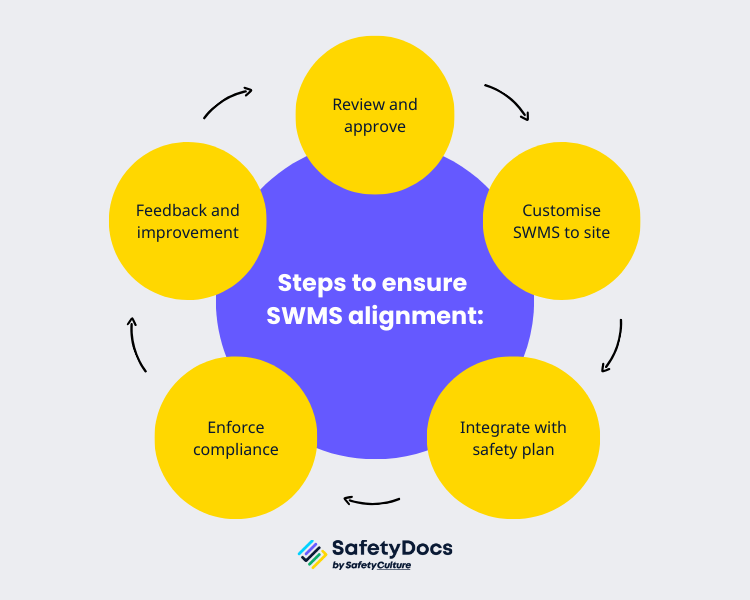Managing contractors on construction sites poses unique challenges, from communication gaps to conflicting procedures. However, contractors are responsible for ensuring the safety of workers and subcontractors.
In Australia, contractors have specific WHS Duties to protect the health and safety of their workers. This responsibility highlights the importance of taking a proactive approach to contractor safety management. To effectively manage contractors and maintain safety standards on construction sites, here are ten essential OHS strategies to implement:
1. Set Pre-qualification Criteria
Pre-qualifying contractors is a crucial first step to knowing whether their safety records, training, and OHS systems meet your standards. Having criteria in place can save you time and resources, knowing that only qualified contractors are selected for your projects. Here are key points to guide you in the criteria:
- Selection Criteria: Major criteria include managerial capability, financial stability, safety record, project expertise, licensing, bonding, and insurance criteria.
- Technical Criteria: Manpower, technical staff, years of experience, and equipment
- Risk Mitigation: Pre-qualifying subcontractors helps general contractors identify reliable, skilled, and financially stable partners
- Quality Assurance: Ensure contractors adhere to your quality management system and have undergone independent pre-qualification reviews.
2. Develop a Comprehensive Contractor Manual
Set clear expectations with a contractor manual outlining your site-specific rules, reporting procedures, and safety standards. This manual serves as a reference point for contractors, reminding them of their safety responsibilities on your site. It should include the following:
- Emergency procedures and evacuation plans
- Incident reporting protocols and forms
- Hazard identification procedures
- Permit to Work process
- Disciplinary measures for non-compliance and;
- Expectations for subcontractor management
3. Include OHS Clauses in Contracts
OHS contract clauses outline the responsibilities of all parties involved, performance expectations, and potential consequences for non-compliance. For example, a subcontractor may be required to adhere to specific safety measures and provide evidence of risk management processes. If contracts do not explicitly state OHS expectations, it may create ambiguity and confusion regarding safety responsibilities.
Examples of OHS clauses include:
- Compliance with relevant laws and regulations
- Provision of necessary PPE and training
- Reporting of all incidents or hazards
4. Make Site-Specific Orientations Mandatory
Before starting work on-site, contractor workers must undergo mandatory site-specific orientations. This cannot be optional as it ensures that all workers know the site's hazards, safety procedures, and emergency protocols. This is also an opportunity to communicate your expectations for OHS compliance. You can do site orientations during toolbox talks or safety meetings.
5. Establish Clear Communication Channels
Establish clear communication channels such as:
- Regular safety meetings for updates and to address safety concerns.
- Multilingual signage to ensure that all workers can understand essential safety messages.
- A streamlined incident reporting system

6. Align SWMS with Site Hazards
Safe Work Method Statements (SWMS) are critical documents required for high-risk construction work in the construction industry. Alignment ensures that all contractors are on the same page regarding construction safety protocols. When SWMS are in sync with the broader site safety plan, it minimises confusion and discrepancies, leading to a more seamless and safer work environment.
Steps to Ensure SWMS Alignment:
- Review and Approve: Evaluate contractors’ SWMS for site-specific hazards. Approve only compliant SWMS.
- Customise SWMS to Site: If necessary, tweak SWMS to align with site-specific hazards.
- Integrate with Safety Plan: Ensure that SWMS are integral to the broader safety plan. Communicate changes to all relevant parties.
- Enforce Compliance: Monitor and enforce adherence to approved SWMS.
- Feedback and Improvement: Gather feedback and continually improve site-specific SWMS to ensure alignment with on-site hazards.

7. Conduct Joint Site Inspections
Collaborating with subcontractors on regular site inspections effectively identifies and addresses potential safety hazards on time. This also promotes open communication and builds trust between general contractors and subcontractors.
Tips for conducting joint construction site inspections:
- Schedule regular inspections at different project stages, not just at the beginning or end.
- Encourage subcontractor participation by involving them in hazard identification and solution implementation.
8.Verify Contractor Competency
While prequalifying contractors can help identify suitable partners, it is also essential to continually verify their competency. This is crucial for maintaining high safety standards. This can include:
- Periodic training updates
- Site-specific competency assessments for new tasks or equipment
9. Maintain Consistent PPE Standards
Personal Protective Equipment (PPE) is critical in preventing injuries and fatalities on construction sites. Contractors must be aware of the required PPE and adhere to it consistently. Uniform standards prevent lapses in protection.
For example, a contractor may provide hard hats, but if workers do not wear them consistently, it increases the risk of head injuries. Consistent PPE standards can be maintained through regular toolbox talks and enforcing disciplinary measures.
10. Monitor Contractor Work and Provide Feedback
Finally, monitoring and providing feedback to contractors can help maintain high safety standards on your site. It allows you to identify any potential issues or areas for improvement and address them promptly. This also shows that you take OHS seriously and are committed to creating a safe work environment for everyone involved in the construction process and project.
Some ways to monitor contractor work include:
- Regular site walks/inspections
- Reviewing incident reports
- Conducting safety audits
Some ways to provide feedback to contractor work include:
- Recognising and acknowledging safe practices
- Addressing any non-compliance issues immediately
- Providing feedback on SWMS and safety procedures

Components of Effective OHS Strategies
Knowing OHS strategies is one thing, but knowing what constitutes an effective OHS strategy is another. Here are the key components of an effective OHS strategy:
Management Leadership and Commitment
Senior management provides the organisation's vision, establishes policy, sets goals, and allocates resources to support OHS programs and systems. Without their commitment, integrating OHS into the organisation's culture will be challenging.
Joint Health and Safety Committee & Representatives
The workers elect Health and Safety Representatives to represent their interests in health and safety matters. Joint HSCs and HSRs are made up of worker and management representatives. They serve as the primary vehicle for worker participation in the OHS program.
Hazard Identification, Assessment and Control
Identifying hazards is the first step toward preventing workplace injuries and illnesses. These critical activities are necessary to recognise the potential health risks, and develop appropriate control measures. Thus, an OHS strategy will be ineffective.
Inspection of Premises, Equipment, Workplaces & Work Practices
The effectiveness of OHS strategies cannot be assessed by only looking at incidents. Regular inspections of premises, equipment, workplaces, and work practices can help identify signs of potential hazards that have not been previously recognised.
Incident Reporting and Investigation
Reporting incidents enables companies to take corrective actions to prevent similar events from occurring in the future. Failure to do so could lead to severe consequences. An incident reporting system allows for prompt, thorough investigations that improve safety procedures.
Safe Work Procedures and Written Instructions
Safety documents for procedures and instructions provide detailed guidance on completing a task safely while minimising the risk of accidents. These documents can be used as a training tool for new workers and as a reference and safety checklist for experienced workers.
Emergency Preparedness and Response Plans
Create detailed emergency response plans covering various scenarios, including natural disasters, fires, and spills. OHS strategies should also involve providing workers with training in emergency response procedures and conducting drills regularly.
Manage Contractors with SafetyDocs
Effective contractor management is vital to maintaining high safety standards on construction sites. SafetyDocs by SafetyCulture can help you streamline this process by providing all the necessary safety documents, from checklists, forms, registers and SWMS templates.
Safety is a collective responsibility, and everyone must do their part. With the right tools and processes in place, managing contractors will be more manageable, and maintaining high safety standards on your site will become second nature. Start implementing these OHS strategies and use these templates:
- Construction Contractor Management Plan
- Contractor Register
- Contractor Pre-Qualification Checklist
- Contractor Project Handbook
Leave the complexity behind and use SafetyDocs to help you manage contractors more effectively. Contact us today to learn more.
Our team of experts is dedicated to providing accurate and informative content. Craig Cruickshank, our senior HSEQ advisor at SafetyDocs by SafetyCulture has reviewed this blog post to ensure the highest level of quality.
Learn more about Craig's work on LinkedIn for more industry insights.
Available for instant download and supplied in fully editable MS Word format for use in your business.
Please note that the above information is provided as a comment only and should not be relied on as professional, legal or financial advice.
Share This Article
